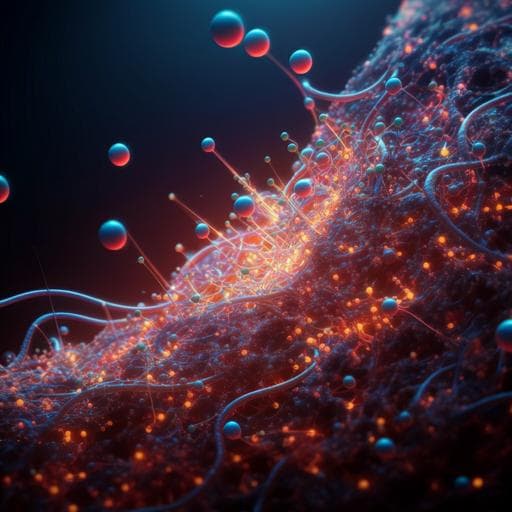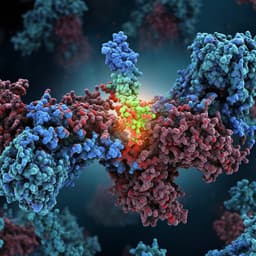
Chemistry
Accelerated discovery of molecular nanojunction photocatalysts for hydrogen evolution by using automated screening and flow synthesis
W. Zhang, M. Yu, et al.
This research, conducted by Weiwei Zhang and colleagues, showcases the accelerated discovery of molecular nanojunction photocatalysts, achieving impressive hydrogen evolution rates and quantum efficiencies. The findings highlight the critical role of molecular architecture and energy binding in optimizing these materials for enhanced performance.
~3 min • Beginner • English
Introduction
The study addresses the challenge of rapidly discovering and optimizing multicomponent organic semiconductors, where performance depends on both chemical composition and processing-dependent morphology/microstructure. Traditional one-variable-at-a-time approaches struggle with the vast donor–acceptor design space and often yield results that are not transferable from small-scale screening to bulk production. Heterojunction organic semiconductor nanoparticles have shown promise for photocatalytic hydrogen evolution, but polymer-based systems face issues such as molecular weight control and batch variability. Small molecules offer defined structures and high crystallinity but have been less explored for photocatalytic hydrogen evolution. The research question is whether a materials acceleration platform that combines a combinatorial small-molecule donor–acceptor library, automated high-throughput screening, and scalable flow synthesis can rapidly identify and translate high-performing nanojunction photocatalysts to bulk production while elucidating structure–property descriptors that govern activity.
Literature Review
Prior work highlights: high-throughput experimentation can accelerate materials discovery but often lacks transferability to scale (refs 14–24). Organic semiconductor heterojunction nanoparticles enhance exciton dissociation and charge separation for solar hydrogen production (refs 25–30), mostly using polymer donors with molecular acceptors; polymer systems can suffer from molecular-weight control and batch variability. Small-molecule organic semiconductors offer precise structures and crystallinity and have seen limited application in photocatalytic hydrogen evolution (refs 32–34). Processing conditions strongly affect semiconductor morphology and properties, causing variability across labs (refs 11–13). This context motivates exploring small-molecule donor–acceptor nanojunctions using a combinatorial and automated approach to navigate the large chemical space efficiently and to ensure scalability via flow synthesis.
Methodology
Combinatorial library synthesis: A two-step, metal-free Hantzsch pyridine condensation (with β-keto nitriles) produced 26 cyano-substituted pyridine (CNP) molecular acceptors with >50% isolated yields for most entries. Acceptors span electron-donating and electron-withdrawing peripheral substituents and positional variations.
Nanojunction formation and high-throughput screening: Six electron-rich donor dyes (WS-37, MK-2, WS-67, Coumarin 6, WS-5F, MTPA-CA) were combined with the 26 CNP acceptors via ultrasonic nanoprecipitation (UNP). Donor and acceptor were dissolved in THF, mixed with surfactant S1, and rapidly injected into water under ultrasonication; THF was evaporated to yield colloidal donor–acceptor nanoparticles. An automated workflow (Chemspeed SWING) dispensed H2PtCl6 (3 wt% Pt relative to catalyst) and ascorbic acid (0.2 ml of 1 M) into 10 ml vials containing 5 ml catalyst dispersion, followed by N2 purging, capping, and uniform AM1.5G illumination in a 48-sample parallel photoreactor; evolved hydrogen was quantified by automated headspace GC. First-round screening covered 156 D–A pairs plus 32 single components; a second round tested MTPA-CA analogues (MCZ-CA, MCZ-CA2, MTPA-Br, TPA-BT-Br, ID-BT-Br) with selected acceptors.
Scale-up by flash nanoprecipitation (FNP): Lead nanojunctions were scaled using a multi-inlet vortex mixer to mix THF (organic stream containing donor, acceptor, surfactant S1) with water streams at controlled flow rates (15/15/30/30 ml min−1). Residual THF was removed at 35 °C to yield aqueous nanojunction dispersions. Photocatalysis of FNP samples was measured in a closed-circulation reactor (25 ml dispersion, 1.56 mg catalyst, 0.2 M ascorbic acid, platinum co-catalyst; 300 W Xe lamp, 10 °C). Donor–acceptor mass ratio and Pt loading were optimized.
Characterization: Morphology and composition were probed by SEM, HAADF-STEM, EDX mapping, and cryo-TEM; crystallinity assessed by PXRD. Optical properties measured by UV–vis absorption, steady-state PL, emission lifetimes, and ultrafast transient absorption spectroscopy. Energy levels estimated from absorption and cyclic voltammetry.
Computational analysis: For 186 D–A combinations, initial interface geometries were sampled and optimized using GFN-xTB (xTB), then re-optimized at DFT/CAM-B3LYP/def2-SVP (Gaussian16). Binding energy Eb = EDA − ED − EA was computed. Electronic couplings VLL (donor LUMO–acceptor LUMO) and VHL (donor HOMO–acceptor LUMO) were calculated as charge-transfer integrals. Relationships among Eb, VLL, VHL, and HER were analyzed, including UMAP dimensionality reduction.
Key Findings
- High-throughput UNP screening of 186 combinations (156 D–A pairs + 30 in a second round) identified several active nanojunctions within 3 days (excluding synthesis time). Top performers after FNP scale-up (HER, mmol h−1 g−1): MTPA-CA:CNP147 (214.4), MCZ-CA:CNP36 (187.2), MTPA-CA:CNP80 (169.6), MTPA-CA:CNP36 (143.8), MTPA-CA:CNP35 (129.5), MTPA-CA:CNP8 (92.2). Control MTPA-CA:CNP126 remained low (2.6).
- Optimized MTPA-CA:CNP147 via FNP at 4:6 wt/wt and 9 wt% Pt achieved an exceptional HER of 330.3 mmol h−1 g−1 under full-spectrum Xe lamp (289 mW cm−2), evolving 2,576 µmol H2 in 5 h from 1.56 mg catalyst. Under AM1.5G (100 mW cm−2), HER was 157.5 mmol h−1 g−1.
- External quantum efficiency (EQE) peaked at 80.3% (350 nm); 72.5% (365 nm); 19.9% (400 nm); 8.5% (420 nm); 3.7% (500 nm). EQE maximum coincides with ICT absorption overlap, consistent with synergistic excitation of both donor and acceptor.
- Nanojunction morphology: one-dimensional nanofibres (~30 nm width, lengths of several micrometres). Cryo-TEM revealed crystalline domains with lattice spacings of 1.60 and 1.14 nm. PXRD of blends matched CNP147; no MTPA-CA diffraction peak detected (suggesting amorphous MTPA-CA coating on CNP147 fibres).
- Photophysics: Strong PL quenching and shortened emission lifetimes in blends vs. CNP147 alone indicate efficient exciton dissociation and charge transfer. Transient absorption showed faster decay of CNP147 excited-state absorption at 450 nm in blends, consistent with interfacial charge transfer. Energy-level alignment suggests type II heterojunction enabling electron transfer from MTPA-CA to CNP147 and hole transfer from CNP147 to MTPA-CA.
- Activity requires nanojunction construction: a physical mixture of separate MTPA-CA and CNP147 nanoparticles yielded much lower HER (66.6 mmol h−1 g−1).
- Scale-up: FNP continuous synthesis produced >1 litre of catalyst dispersion (≈200× screening scale) with comparable HER (305.4 mmol h−1 g−1) and similar morphology to screening materials.
- Computational correlations: HER exhibits a volcano-like dependence on donor–acceptor binding energy Eb, with optimal activity at Eb ≈ 0.15–0.25 eV; a similar volcano trend with VLL ≈ 0.02–0.06 eV; HER decreases monotonically with increasing VHL. UMAP embeddings suggest clustering of high-HER combinations in the Eb–VLL–VHL space.
- Sensitivity to structure: small changes in acceptor substituents drastically affect activity; among fluorinated acceptors (CNP106/108/118/147), only CNP147 delivers the top-performing nanojunction with MTPA-CA.
Discussion
The integrated platform successfully addresses the dual challenge of exploring a large donor–acceptor chemical space and translating small-scale screening results to scalable production. High-throughput UNP screening rapidly pinpointed active small-molecule nanojunctions, and FNP provided a reliable pathway to produce morphologically consistent materials at scale with retained or improved performance after compositional optimization. The best-performing MTPA-CA:CNP147 forms type II heterojunction nanofibres with substantial crystallinity (from the acceptor component) and intimate mixing, enabling efficient exciton dissociation and long-lived charges, as evidenced by PL quenching, lifetime shortening, and transient absorption. The fibre morphology likely aids charge transport and reduces recombination compared to common spherical heterojunction nanoparticles. Computational analysis across 186 D–A pairs indicates that an intermediate donor–acceptor binding energy and moderate LUMO–LUMO coupling maximize HER, whereas strong HOMO–LUMO coupling correlates with enhanced recombination and lower activity. These descriptors, alongside suitable energy-level offsets and absorption complementarity, provide a rational guide for designing future molecular heterojunction photocatalysts. The transferability from automated screening to FNP scale-up demonstrates practical applicability for producing high-performance catalysts in bulk.
Conclusion
A materials acceleration platform combining combinatorial small-molecule libraries, automated high-throughput screening, and flow-based flash nanoprecipitation enables rapid discovery and scalable production of molecular donor–acceptor nanojunction photocatalysts. The optimized MTPA-CA:CNP147 nanojunction achieves state-of-the-art sacrificial hydrogen evolution (330.3 mmol h−1 g−1) with an EQE of 80.3% at 350 nm and can be produced at ≥1 litre scale with preserved morphology and performance. Photophysical evidence supports efficient charge separation in one-dimensional nanofibre architectures. Computational structure–activity correlations identify moderate donor–acceptor binding energy and electronic coupling as key factors, offering a design rule for future organic heterojunction photocatalysts. The generalizable strategy of coupling small-scale screening to flow synthesis may accelerate discovery in other photoredox and optoelectronic applications.
Limitations
- Calculated descriptors (binding energy Eb, couplings VLL and VHL) do not include morphological, microstructural, or surface hydrophilicity effects, which can strongly impact activity and help explain inactive pairs with similar Eb/VLL/VHL values to active ones.
- Optimized donor–acceptor interface geometries from calculations may not be fully realized in the actual nanojunctions.
- Energy-level overpotentials alone cannot rationalize activity trends; multiple factors (morphology, crystallinity, interfacial structure) are critical.
- The molecular building block syntheses were not automated and remain time-consuming relative to screening and scale-up steps.
- Initial small-scale UNP and larger-scale FNP involve different mixing mechanisms; although transferability was demonstrated here, such differences can limit generalizability across systems.
- Reported performances are under sacrificial conditions (ascorbic acid, Pt co-catalyst), not overall water splitting.
Related Publications
Explore these studies to deepen your understanding of the subject.







